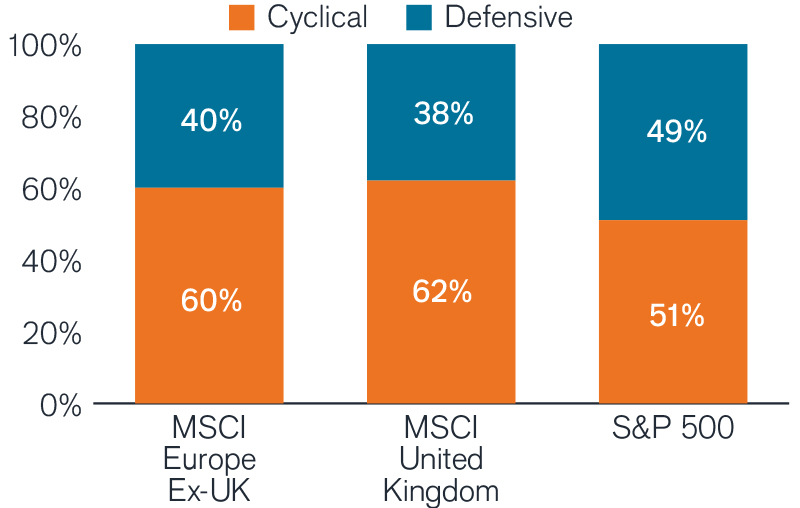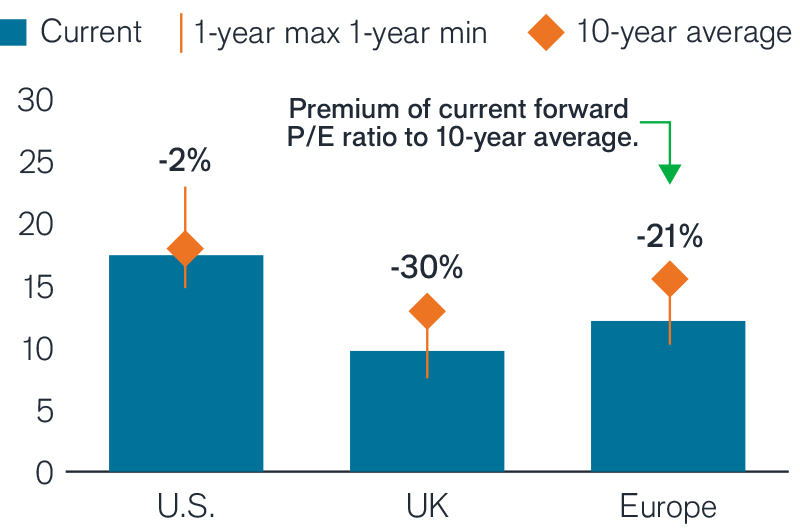Subscribe
Sign up for timely perspectives delivered to your inbox.
The Portfolio Construction and Strategy Team explains why they believe the more cyclical nature of European equities versus the U.S. and their lower relative valuations may present strong upside potential.

This article is part of the latest Trends and Opportunities report, which outlines key themes for the next stage of this market cycle and their nuanced implications across global asset classes.
The more cyclical nature of European equities and their lower relative valuations than U.S. equities present strong upside potential.


Source: (LHS) Janus Henderson Portfolio Construction and Strategy, Morningstar. Cyclical sectors include energy, financials, industrials and materials. Defensive includes communication services, consumer discretionary, consumer staples, healthcare, technology, real estate and utilities. As at 31 December 2022. (RHS) Janus Henderson Portfolio Construction and Strategy, Bloomberg. Forward P/E Ratio as at December 2022.

Source: Janus Henderson Portfolio Construction and Strategy, Morningstar, as at December 2022. Stoxx 600, S&P 500 Index, MSCI World Value, MSCI World Growth, total return indices. 10-Year U.S. Treasury yield (%). Past performance does not predict future returns.
Footnote
1 Source: Morningstar as at 31 December 2022
10-Year Treasury Yield is the interest rate on U.S. Treasury bonds that will mature 10 years from the date of purchase.
MSCI Europe ex UK IndexSM reflects the equity market performance of developed markets in Europe, excluding the United Kingdom.
MSCI United Kingdom IndexSM reflects the equity market performance of developed markets in the United Kingdom.
MSCI World Growth IndexSM reflects the performance of growth stocks from global developed markets.
MSCI World Value IndexSM reflects the performance of large and mid cap equity securities exhibiting value style characteristics across global developed markets.
Price-to-Earnings (P/E) Ratio measures share price compared to earnings per share for a stock or stocks in a portfolio.
S&P 500® Index reflects U.S. large-cap equity performance and represents broad U.S. equity market performance.
STOXX® Europe 600 Index represents large, mid and small capitalization companies across 17 countries in the European region.
IMPORTANT INFORMATION
Equity securities are subject to risks including market risk. Returns will fluctuate in response to issuer, political and economic developments.
Foreign securities are subject to additional risks including currency fluctuations, political and economic uncertainty, increased volatility, lower liquidity and differing financial and information reporting standards, all of which are magnified in emerging markets.
Growth stocks are subject to increased risk of loss and price volatility and may not realize their perceived growth potential.
Value stocks can continue to be undervalued by the market for long periods of time and may not appreciate to the extent expected.